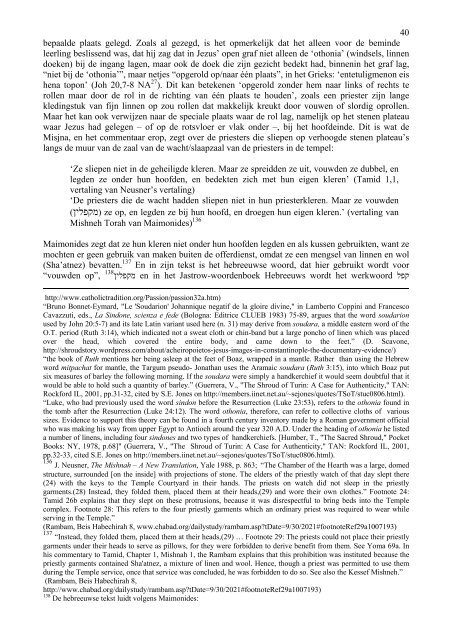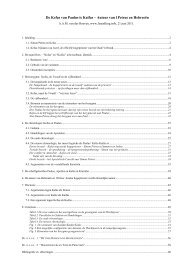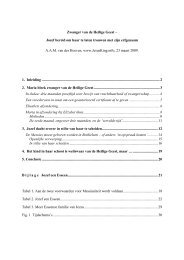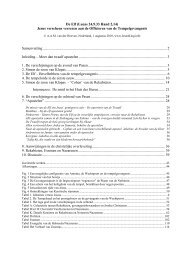Johannes Marcus – Auteur van het Johannes ... - JesusKing.info
Johannes Marcus – Auteur van het Johannes ... - JesusKing.info
Johannes Marcus – Auteur van het Johannes ... - JesusKing.info
Create successful ePaper yourself
Turn your PDF publications into a flip-book with our unique Google optimized e-Paper software.
40<br />
bepaalde plaats gelegd. Zoals al gezegd, is <strong>het</strong> opmerkelijk dat <strong>het</strong> alleen voor de beminde<br />
leerling beslissend was, dat hij zag dat in Jezus’ open graf niet alleen de ‘othonia’ (windsels, linnen<br />
doeken) bij de ingang lagen, maar ook de doek die zijn gezicht bedekt had, binnenin <strong>het</strong> graf lag,<br />
“niet bij de ‘othonia’”, maar netjes “opgerold op/naar één plaats”, in <strong>het</strong> Grieks: ‘entetuligmenon eis<br />
hena topon’ (Joh 20,7-8 NA 27 ). Dit kan betekenen ‘opgerold zonder hem naar links of rechts te<br />
rollen maar door de rol in de richting <strong>van</strong> één plaats te houden’, zoals een priester zijn lange<br />
kledingstuk <strong>van</strong> fijn linnen op zou rollen dat makkelijk kreukt door vouwen of slordig oprollen.<br />
Maar <strong>het</strong> kan ook verwijzen naar de speciale plaats waar de rol lag, namelijk op <strong>het</strong> stenen plateau<br />
waar Jezus had gelegen <strong>–</strong> of op de rotsvloer er vlak onder <strong>–</strong>, bij <strong>het</strong> hoofdeinde. Dit is wat de<br />
Misjna, en <strong>het</strong> commentaar erop, zegt over de priesters die sliepen op verhoogde stenen plateau’s<br />
langs de muur <strong>van</strong> de zaal <strong>van</strong> de wacht/slaapzaal <strong>van</strong> de priesters in de tempel:<br />
‘Ze sliepen niet in de geheiligde kleren. Maar ze spreidden ze uit, vouwden ze dubbel, en<br />
legden ze onder hun hoofden, en bedekten zich met hun eigen kleren’ (Tamid 1,1,<br />
vertaling <strong>van</strong> Neusner’s vertaling)<br />
‘De priesters die de wacht hadden sliepen niet in hun priesterkleren. Maar ze vouwden<br />
(ןילפקמ) ze op, en legden ze bij hun hoofd, en droegen hun eigen kleren.’ (vertaling <strong>van</strong><br />
Mishneh Torah <strong>van</strong> Maimonides) 136<br />
Maimonides zegt dat ze hun kleren niet onder hun hoofden legden en als kussen gebruikten, want ze<br />
mochten er geen gebruik <strong>van</strong> maken buiten de offerdienst, omdat ze een mengsel <strong>van</strong> linnen en wol<br />
(Sha’atnez) bevatten. 137 En in zijn tekst is <strong>het</strong> hebreeuwse woord, dat hier gebruikt wordt voor<br />
138<br />
“vouwden op”, ןילפקמ en in <strong>het</strong> Jastrow-woordenboek Hebreeuws wordt <strong>het</strong> werkwoord לפק<br />
http://www.catholictradition.org/Passion/passion32a.htm)<br />
“Bruno Bonnet-Eymard, "Le 'Soudarion' Johannique negatif de la gloire divine," in Lamberto Coppini and Francesco<br />
Cavazzuti, eds., La Sindone, scienza e fede (Bologna: Editrice CLUEB 1983) 75-89, argues that the word soudarion<br />
used by John 20:5-7) and its late Latin variant used here (n. 31) may derive from soudara, a middle eastern word of the<br />
O.T. period (Ruth 3:14), which indicated not a sweat cloth or chin-band but a large poncho of linen which was placed<br />
over the head, which covered the entire body, and came down to the feet.” (D. Scavone,<br />
http://shroudstory.wordpress.com/about/acheiropoietos-jesus-images-in-constantinople-the-documentary-evidence/)<br />
“the book of Ruth mentions her being asleep at the feet of Boaz, wrapped in a mantle. Rather than using the Hebrew<br />
word mitpachat for mantle, the Targum pseudo- Jonathan uses the Aramaic soudara (Ruth 3:15), into which Boaz put<br />
six measures of barley the following morning. If the soudara were simply a handkerchief it would seem doubtful that it<br />
would be able to hold such a quantity of barley.” (Guerrera, V., "The Shroud of Turin: A Case for Authenticity," TAN:<br />
Rockford IL, 2001, pp.31-32, cited by S.E. Jones on http://members.iinet.net.au/~sejones/quotes/TSoT/stuc0806.html).<br />
“Luke, who had previously used the word sindon before the Resurrection (Luke 23:53), refers to the othonia found in<br />
the tomb after the Resurrection (Luke 24:12). The word othonia, therefore, can refer to collective cloths of various<br />
sizes. Evidence to support this theory can be found in a fourth century inventory made by a Roman government official<br />
who was making his way from upper Egypt to Antioch around the year 320 A.D. Under the heading of othonia he listed<br />
a number of linens, including four sindones and two types of handkerchiefs. [Humber, T., "The Sacred Shroud," Pocket<br />
Books: NY, 1978, p.68]" (Guerrera, V., "The Shroud of Turin: A Case for Authenticity," TAN: Rockford IL, 2001,<br />
pp.32-33, cited S.E. Jones on http://members.iinet.net.au/~sejones/quotes/TSoT/stuc0806.html).<br />
136 J. Neusner, The Mishnah <strong>–</strong> A New Translation, Yale 1988, p. 863; “The Chamber of the Hearth was a large, domed<br />
structure, surrounded [on the inside] with projections of stone. The elders of the priestly watch of that day slept there<br />
(24) with the keys to the Temple Courtyard in their hands. The priests on watch did not sleep in the priestly<br />
garments.(28) Instead, they folded them, placed them at their heads,(29) and wore their own clothes.” Footnote 24:<br />
Tamid 26b explains that they slept on these protrusions, because it was disrespectful to bring beds into the Temple<br />
complex. Footnote 28: This refers to the four priestly garments which an ordinary priest was required to wear while<br />
serving in the Temple.”<br />
(Rambam, Beis Habechirah 8, www.chabad.org/dailystudy/rambam.asp?tDate=9/30/2021#footnoteRef29a1007193)<br />
137 “Instead, they folded them, placed them at their heads,(29) … Footnote 29: The priests could not place their priestly<br />
garments under their heads to serve as pillows, for they were forbidden to derive benefit from them. See Yoma 69a. In<br />
his commentary to Tamid, Chapter 1, Mishnah 1, the Rambam explains that this prohibition was instituted because the<br />
priestly garments contained Sha'atnez, a mixture of linen and wool. Hence, though a priest was permitted to use them<br />
during the Temple service, once that service was concluded, he was forbidden to do so. See also the Kessef Mishneh.”<br />
(Rambam, Beis Habechirah 8,<br />
http://www.chabad.org/dailystudy/rambam.asp?tDate=9/30/2021#footnoteRef29a1007193)<br />
138 De hebreeuwse tekst luidt volgens Maimonides:





